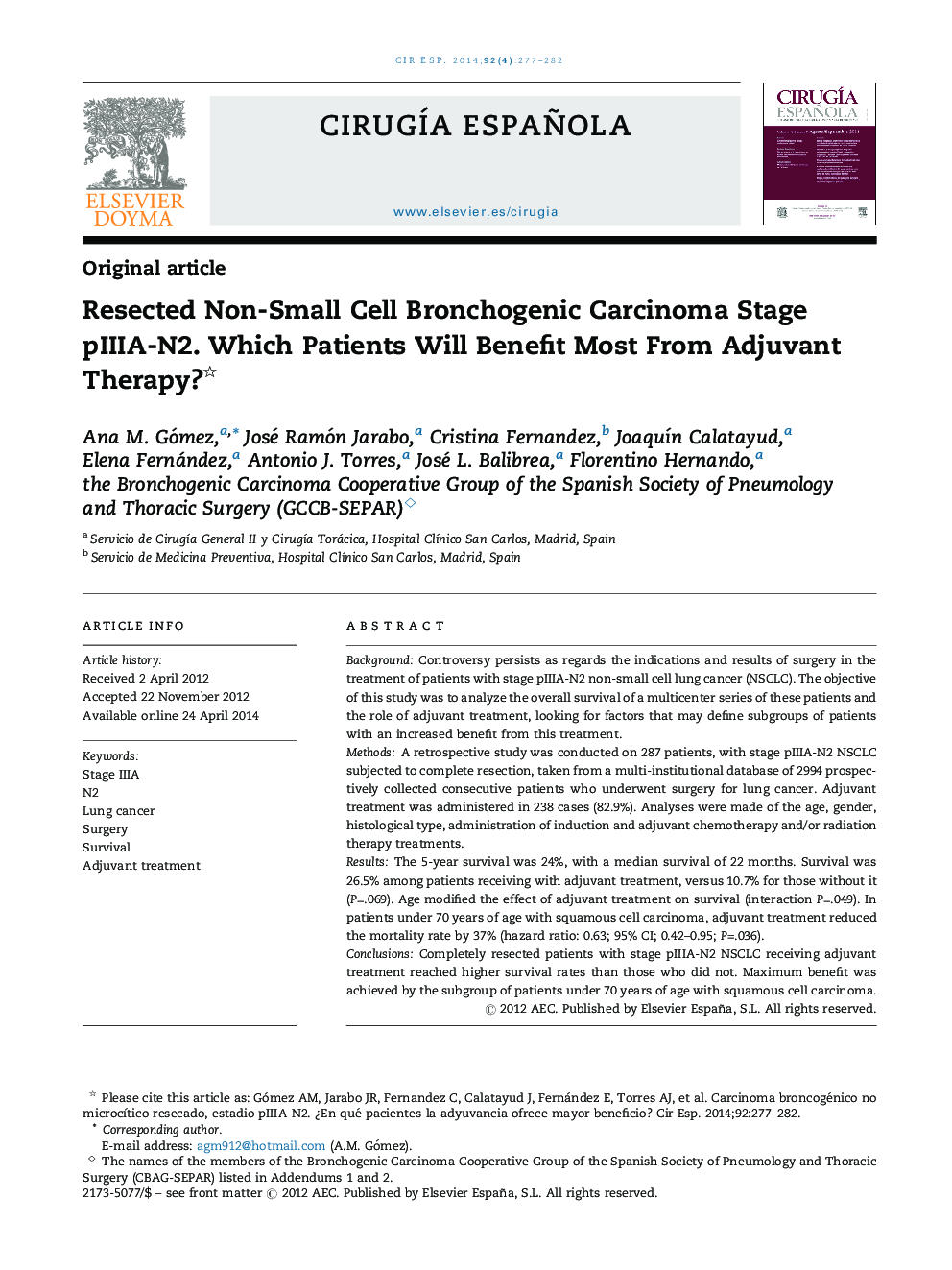| کد مقاله | کد نشریه | سال انتشار | مقاله انگلیسی | نسخه تمام متن |
|---|---|---|---|---|
| 4255010 | 1284417 | 2014 | 6 صفحه PDF | دانلود رایگان |

BackgroundControversy persists as regards the indications and results of surgery in the treatment of patients with stage pIIIA-N2 non-small cell lung cancer (NSCLC). The objective of this study was to analyze the overall survival of a multicenter series of these patients and the role of adjuvant treatment, looking for factors that may define subgroups of patients with an increased benefit from this treatment.MethodsA retrospective study was conducted on 287 patients, with stage pIIIA-N2 NSCLC subjected to complete resection, taken from a multi-institutional database of 2994 prospectively collected consecutive patients who underwent surgery for lung cancer. Adjuvant treatment was administered in 238 cases (82.9%). Analyses were made of the age, gender, histological type, administration of induction and adjuvant chemotherapy and/or radiation therapy treatments.ResultsThe 5-year survival was 24%, with a median survival of 22 months. Survival was 26.5% among patients receiving with adjuvant treatment, versus 10.7% for those without it (P=.069). Age modified the effect of adjuvant treatment on survival (interaction P=.049). In patients under 70 years of age with squamous cell carcinoma, adjuvant treatment reduced the mortality rate by 37% (hazard ratio: 0.63; 95% CI; 0.42–0.95; P=.036).ConclusionsCompletely resected patients with stage pIIIA-N2 NSCLC receiving adjuvant treatment reached higher survival rates than those who did not. Maximum benefit was achieved by the subgroup of patients under 70 years of age with squamous cell carcinoma.
ResumenIntroducciónLas indicaciones y resultados de la cirugía en el tratamiento de pacientes con carcinoma broncogénico no microcítico (CBNM) en estadio IIIA-N2 continúa siendo objeto de debate. Este estudio analiza la supervivencia global y el papel del tratamiento adyuvante en una serie multicéntrica de pacientes en estadio IIIA-N2 completamente resecados, buscando factores que puedan definir subgrupos de pacientes en quienes esta adyuvancia resulte más beneficiosa.Material y métodosEstudio retrospectivo de una serie multicéntrica de pacientes con CBNM resecado en estadio IIIA por N2 tomados de una base de datos con 2.994 pacientes intervenidos por CBNM recogidos prospectivamente. Se estudia la supervivencia y la influencia de las variables edad, género, tipo histológico y administración de tratamiento neoadyuvante y coadyuvante con quimioterapia o radioterapia.ResultadosLa supervivencia global de la serie a 5 años fue del 24% con una supervivencia media de 22 meses. En pacientes con tratamiento adyuvante fue de 26,5%, contra un 10,7% en aquellos sin adyuvancia (p = 0,069). La edad modificó el efecto de la adyuvancia (interacción p = 0,049). En pacientes por debajo de 70 años con carcinoma epidermoide, el tratamiento adyuvante redujo la tasa de mortalidad un 37% (hazard ratio: 0,63; p = 0,036).ConclusionesEl tratamiento adyuvante aumentó la supervivencia en los pacientes con CBNM resecado en estadio IIIA-N2. El beneficio fue mayor en pacientes de menos de 70 años con carcinoma epidermoide.
Journal: Cirugía Española (English Edition) - Volume 92, Issue 4, April 2014, Pages 277–282